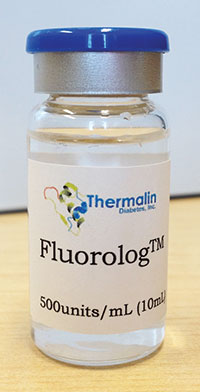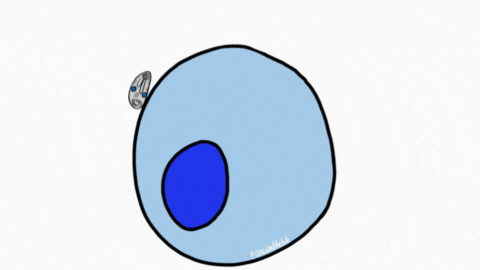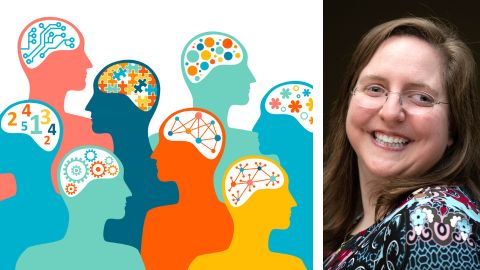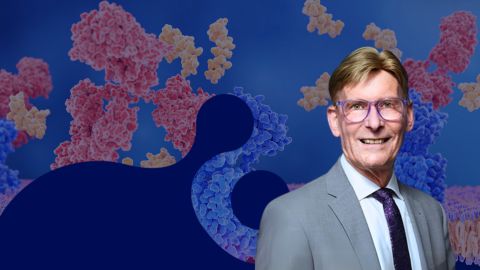Insulin for all
When Michael Weiss decided to pursue diabetes research in the 1980s, some of his mentors tried to change his mind. “There was this impression that diabetes was a static field,” says Weiss. His mentors wondered why an M.D./Ph.D. from Harvard University like Weiss would want to study insulin when everything important about the hormone, which regulates blood glucose, was deemed to be known already.

“But it seemed on my clinical rotations as a medical student that so many of the patients in the intensive care units and the cardiac catherization lab had diabetes,” says Weiss. He had a feeling that diabetes would become a bigger global health problem as time went on.
Compounding what Weiss saw in Boston-area hospitals was what he experienced during one pivotal year of his life. In 1980, Weiss took a year off from graduate and medical school to travel through Europe, Africa and the Middle East. In underdeveloped parts of Africa, Weiss was thunderstruck to see how difficult life was for people without access to resources that were taken for granted in the developed world. He heard stories from local physicians about how villagers struggled to use medicines, such as insulin, that degrade without refrigeration. As he listened to the tales, Weiss recalls, he couldn’t help but think “that would be an easy problem to solve.” He says, “One would be able to engineer ultra heat-stable insulin.”
But it wasn’t an easy problem to solve. “Such is the naiveté of a 23-year-old,” remarks Weiss.
Now, 34 years later and a whole lot savvier, Weiss is closer to having an ultra heat-stable insulin analog that doesn’t require refrigeration. The work in Weiss’ laboratory at Case Western Reserve University has been spun off as Thermalin Diabetes, a company in Cleveland, Ohio. The company is gearing up to do human trials in 2015 of the ultraconcentrated, rapid-acting insulin analog.
An American abroad
In 1978, Weiss entered Harvard Medical School in the M.D./Ph.D. program after completing his undergraduate physics degree at Harvard University. “Harvard has all these obscure endowments. For example, they have one endowment that makes sure that all freshmen get ice cream every day,” says Weiss. Another endowment was the Frederick Sheldon Travelling Fellowship, which Weiss received in his second year of the M.D./Ph.D. program. The fellowship allows undergraduate seniors and students at graduate or medical schools to take a year to travel abroad. Undergraduate seniors can’t stop in any one place for too long, but graduate and medical students can have a home base in a foreign country and travel from there. “My parents thought that it was ill-advised to interrupt my training,” says Weiss. “But it turned out to be a turning point in my scientific interest.”
Weiss made Oxford University his home base in the U.K. One of his mentors, Irving London, who was based in both Harvard and the Massachusetts Institute of Technology, had connections with several scientists at Oxford and made introductions. At Oxford, Weiss met Dorothy Crowfoot Hodgkin and her lab members. Hodgkin had won the 1964 Nobel Prize in chemistry for her X-ray crystallography work on biologically important molecules. In meeting her, Weiss’ curiosity in insulin was piqued, because it was a molecule whose crystal structure Hodgkin had been pursuing for decades.
Insulin was first described in 1922 by Frederick Banting and Charles Best in John Macleod’s laboratory at the University of Toronto (for the work, Banting and McLeod received the Nobel Prize in medicine and physiology in 1923). Once insulin’s role in glucose homeostasis became apparent, researchers began to study its biochemical and structural underpinnings. Hodgkin herself started to work on the crystal structures of insulin in the 1930s but didn’t get any results until the 1960s. Her perseverance and tenacity made a powerful impression on Weiss.
Weiss traveled next through Greece, Israel and Kenya further deepened his interest in insulin. In Kenya, Weiss was struck by the number of villages not connected to the electrical grid. When he visited a few Kenyan clinics, he listened as doctors described to him the lengths to which patients went to use insulin and other Western drugs, even going so far as burying the medicines in the ground to keep them cool.
Once he completed the Sheldon fellowship, Weiss continued with his medical and scientific training at Harvard and MIT. After he completed his M.D./Ph.D. (his Ph.D. was done under Martin Karplus, who received the Nobel Prize in chemistry last year) and became a research resident in the Boston area, Weiss found his interest in insulin solidifying.
While most scientists around Weiss were doubtful that the study of insulin had much to yield, he had several supporters, one of whom was Leo Neuringer, who headed an NMR laboratory and whose son had developed diabetes. Neuringer “encouraged the students, fellows and young doctors who were coming through the lab to focus their efforts on diabetes,” says Weiss. “I remember being teased by one of my peers that finally Leo found someone gullible enough to do this!”
In the dead zone

In 1988, Weiss started his laboratory in Boston with a focus on the molecular underpinnings of insulin’s structure and mechanism of action. (The lab eventually moved to Weiss’ home state of Ohio after a stint at the University of Chicago.) “The easy things were already known, all the low-hanging fruit,” he says. “But the really important questions of how proinsulin folds, how the hormone binds to the receptor, how it degrades – none of these were known.”
Insulin starts off as proinsulin, which has to be processed in the beta cells of the pancreas. The insulin monomer forms a hexameric complex for storage purposes. When the hexamers get secreted from the pancreatic beta cells, the complexes dissociate to liberate the active monomeric form of the hormone that can go on to bind to its receptor.
For one of its early projects, Weiss’ group wanted to use NMR spectroscopy to analyze the structure dynamics of the insulin monomer. Because the monomers are designed by nature to form hexamers, the protein thwarted the investigators by clumping. So Weiss collaborated with Eli Lilly’s Bruce Frank, who “was the pioneer of the biosynthetic expression and purification of insulin in the early 1980s,” says Weiss.
Frank had been part of the team that made the Eli Lilly blockbuster drug Humulin. Until the introduction of Humulin in the 1980s, diabetics had to take insulin isolated from porcine and bovine pancreases. The insulin from animals was expensive, not totally pure and didn’t lend itself well to scaling up production. Humulin, made in bacteria by recombinant DNA technology, bypassed those problems.
Weiss’ group, with Frank’s help, focused on developing monomeric models of insulin that were biologically active under physiological conditions so that they could study its dynamics. As work got under way, Weiss watched as insulin analogs, which are modified versions of natural insulin, began to hit the market in the late 1990s. Eli Lilly got another blockbuster drug out of its first rapid-acting insulin analog, Humalog. Novo Nordisk, Sanofi and Merck introduced insulin analog products into the clinical marketplace.
The first-generation analogs came in two types: rapid-acting and long-lasting. But Weiss noted problems with these analogs. “The bottom line was that the rapid-acting insulin still took too long. The long-acting insulins were still too short. All were too unstable,” he says. “There was a lot of room for continued improvement that could make an even more marked clinical impact on the long-term health of patients.” Weiss confesses that while his laboratory was making the early monomeric analogs, it didn’t occur to him at that time that they may have some commercial value.
In a way, it worked in Weiss’ favor that he didn’t immediately jump in on the action. In the mid-2000s, many of the companies in the business of making insulin analogs decided to exit the market because it seemed saturated. But by 2007 Weiss was getting excited about the analogs his laboratory was producing, because one of them was the heat-stable insulin he had thought of as a youthful, backpacking student.
As the work matured, Weiss pitched it to the Bill and Melinda Gates Foundation to see if the organization would help get the heat-stable insulin analog out to the developing world. But he was stopped in his tracks. “One of the Gates Foundation leaders advised me that I had to take off my academic hat and at least, part time, put on a business hat,” recalls Weiss. “You can’t have a charitable mission in the developing world without having a sensible business plan in affluent societies that makes the whole enterprise possible. HIV medicines are a major market in the west. That provides the foundation for charitable humanitarian use in the developing world.”
The Gates Foundation leader, Richard Klausner, the former head of the National Cancer Institute, urged Weiss to think about how his heat-stable insulin analog would be helpful in the developed world. And that was the same message he heard from one of his good friends.
Live long and prosper
One day in the late 1970s, Richard Berenson and his two college roommates decided to push open the fire door between their undergraduate dorm suite and the adjoining suite at Adams House on the Harvard campus. In the next suite, they found Weiss, who at that time was a senior undergraduate.
 Fluorolog is a rapid-acting, ultraconcentrated insulin analog.
Fluorolog is a rapid-acting, ultraconcentrated insulin analog.
A friendship was struck up between the four men, and from then on, the fire door between the rooms was kept open. A cornerstone of the friendship was a devotion to “Star Trek.” On nights there was a “Star Trek” rerun at 6 p.m. on TV, the four friends would go to dinner early so they could watch the show together. Weiss was already a fan of the original TV series, because he used to watch it with his father back home in Ohio.
Weiss and two of the roommates, Alan Stern and Hamish Norton, went off to get Ph.D.s in science (in Weiss’ case, he added an M.D.); Berenson headed to law and business schools at Harvard (“I am the black sheep,” he quips). Berenson built up a career in venture capital and private equity, working with a string of startups in the biotechnology, technology and media spheres in the Boston area.
One day, when both men were successfully entrenched in their respective career paths, Berenson got a phone call from an excited Weiss. “Mike called me up and said, ‘Rick I’ve invented an insulin that is perfect for the developing world that never needs refrigeration.’ I said, ‘Mike, that’s fantastic. Do you have anything that works in the west? You can’t start a company just on a program for the developing world.’”
Berenson repeated exactly what Weiss had heard from the Gates Foundation. Weiss had to identify a niche for the heat-stable analog in more affluent countries.
In establishing the company Thermalin Diabetes in 2009 with Berenson as its CEO, Weiss and the rest of the team identified things that made Weiss’ new monomeric insulin analogs special for developed-world purposes.
The company’s first candidate is Fluorolog, a rapid-acting, ultraconcentrated insulin analog. Fluorolog gets its name from the fluorine atom present in an ortho-monofluorophenylalanine substituted for a phenylalanine in the analog. The fluorine atom acts to stabilize the entire molecule so it no longer needs to form a hexamer to be stable. Because the molecule doesn’t have to form a hexamer to be active, the analog is not prone to clumping and can be formulated at high concentrations.
Berenson says Fluorolog actually has two market niches in developed countries. One is for type 2 diabetics with high insulin resistance. Right now, these patients have to inject 0.5 mL of insulin into their skin, which is very uncomfortable, explains Berenson.
He adds, “More importantly, when you have that large a volume, it really slows down how quickly the insulin absorbs. The consequence is it’s no longer a meal-time insulin.”
Higher concentrations of insulin don’t help either, because the protein clumps and still would be too slow to act. “There’s no solution for these patients” at the moment, says Berenson, but he sees a place for Fluorolog, because its high concentration will allow diabetics to take in small amounts. Weiss points out that Fluorolog will have a humanitarian benefit in the U.S., because insulin resistance is most prevalent in poorer communities.
The second application is in miniaturized insulin pumps geared for type 1 diabetics. “Today, the constraint in shrinking the size of a pump is the size of the insulin reservoir. If you can make insulin five times as concentrated without losing the rapid action, then you can shrink the reservoir by 80 percent,” explains Berenson. “You can make a matchbook-sized insulin pump or an insulin pump that lasts a whole week.”
The first-generation insulin analogs are scheduled to go off-patent starting this year. The management team at Thermalin Diabetes suggests that the timing is right to start introducing Fluorolog and their other second-generation insulin analogs to a market that is expected to grow from $17 billion today to $70 billion by 2030. Earlier this year, the company received a $1-million pledge from the Juvenile Diabetes Research Foundation International to support its efforts.
Weiss says the company is getting ready to do phase I trials of Fluorolog in which he expects to enroll 12 to 24 volunteers for a single injection of the drug. “One of the amazing things is that so many neighbors and friends in the Cleveland community are volunteering to be in our phase I studies,” says Weiss. “Their families have been touched by diabetes, and this is a way they can make a contribution. It’s really heartwarming.”
Even though he has Berenson as the seasoned businessman at the helm of Thermalin Diabetes, Weiss did some introspection after the Gates Foundation meeting and acknowledged that he knew little about the business management world. To rectify matters, as he reached his 50s, Weiss went back to school, this time to Weatherhead School of Business at Case Western for an MBA. “It was a fantastic experience even though I was twice as old as the other students,” says Weiss, admitting that taking exams again was a struggle.
Berenson has watched his friend combine his scientific, medical and business training. “There are a lot of scientists who might get an MBA and decide that, even without having done it before, they know exactly what to do to run a company,” says Berenson, adding that Weiss has used his MBA training to be more attuned to the business problems and decisions involved in creating products. In meetings with stakeholders, Berenson says he watches Weiss walk the fine line between the idealistic scientist who sees his work changing the lives of ordinary people and the savvy businessman who has an eye on the bottom line. “It’s really interesting to see him navigate that huge desire to make a difference with the need to make sure to stay committed to making a return for our investors,” says Berenson.
Making a difference in the lives of those less fortunate is important to Weiss. Berenson says his friend’s constant consideration of others, such as his graduate students, and care for those in desperate need, such as the villagers he saw in Kenya, are always in the forefront in his day-to-day business.
As the chair of the biochemistry department at Case Western, Weiss gets to uphold some of the values he cherishes in the form of framed Star Trek: The Next Generation posters on the walls of the department office. To Weiss, the posters of the characters Data and Worf illustrate the values highlighted by them, such as conflict resolution and honor. While Berenson identifies himself “as more of a Spock guy,” from the original Star Trek series, Weiss says his favorite character is the doctor, Bones McCoy, because of all the characters in the original TV series, to Weiss, McCoy seems to be “the most human and humane.”
Enjoy reading ASBMB Today?
Become a member to receive the print edition four times a year and the digital edition monthly.
Learn moreGet the latest from ASBMB Today
Enter your email address, and we’ll send you a weekly email with recent articles, interviews and more.
Latest in People
People highlights or most popular articles

Sketching, scribbling and scicomm
Graduate student Ari Paiz describes how her love of science and art blend to make her an effective science communicator.

Embrace your neurodivergence and flourish in college
This guide offers practical advice on setting yourself up for success — learn how to leverage campus resources, work with professors and embrace your strengths.

Survival tools for a neurodivergent brain in academia
Working in academia is hard, and being neurodivergent makes it harder. Here are a few tools that may help, from a Ph.D. student with ADHD.

Quieting the static: Building inclusive STEM classrooms
Christin Monroe, an assistant professor of chemistry at Landmark College, offers practical tips to help educators make their classrooms more accessible to neurodivergent scientists.

Hidden strengths of an autistic scientist
Navigating the world of scientific research as an autistic scientist comes with unique challenges —microaggressions, communication hurdles and the constant pressure to conform to social norms, postbaccalaureate student Taylor Stolberg writes.

Richard Silverman to speak at ASBMB 2025
Richard Silverman and Melissa Moore are the featured speakers at the ASBMB annual meeting to be held April 12-15 in Chicago.

